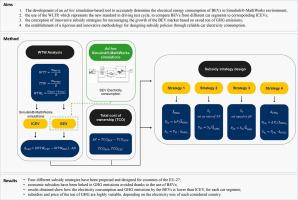Energy Conversion and Management ( IF 10.4 ) Pub Date : 2022-09-30 , DOI: 10.1016/j.enconman.2022.116279 Michele De Santis , Luca Silvestri , Antonio Forcina

|
Decarbonization in the transport sector, especially in private mobility, is one of the main objectives of the European Union (EU) for next few years. Battery electric vehicles (BEVs) represent a promising solution for reducing pollution and GHG emissions; however, their purchase price contributes to curbing their diffusion. In this scenario, the aims of this study are to develop a flexible, simulation-based analysis for EU car fleets in terms of energy consumption and GHG emissions and, based on the simulation results, to propose an innovative system of financial subsidies. This can support governments in encouraging EU customers to prefer sustainable and green options for mobility. Different car segments have been considered; the electrical energy consumptions have been obtained through the development of an ad-hoc simulation model in Simulink®-MathWorks environment, while the Well-To-Wheel analysis has been performed to estimate GHG emissions. Based on these assumptions, four different subsidy strategies have been proposed and designed for countries of the EU-27. According to different logics, economic subsidies have been linked to GHG emissions avoided thanks to the use of BEVs. The results obtained show how BEVs’ consumption of electricity is low, even for larger vehicles, and this allows BEVs to be considered less impactful than internal combustion engine vehicles (ICEV) with respect to GHG emissions. Furthermore, results are highly variable, depending on the electricity mix of each considered country, and they show how, for the countries that use the most renewable sources, the proposed subsidies even can generate gains from consumers’ perspectives.
中文翻译:

促进欧洲电动汽车需求:创新用电模拟器设计和基于油井到车轮分析的补贴策略
交通运输领域的脱碳,特别是私人出行领域的脱碳,是欧盟 (EU) 未来几年的主要目标之一。电池电动汽车 (BEV) 是减少污染和温室气体排放的有前景的解决方案;然而,它们的购买价格有助于抑制它们的扩散。在这种情况下,本研究的目的是针对欧盟车队在能源消耗和温室气体排放方面进行灵活的、基于模拟的分析,并根据模拟结果提出一种创新的财政补贴制度。这可以支持政府鼓励欧盟客户更喜欢可持续和绿色的出行选择。考虑了不同的汽车细分市场;电能消耗是通过在 Simulink®-MathWorks 环境中开发一个临时仿真模型获得的,同时已执行 Well-To-Wheel 分析以估计温室气体排放。基于这些假设,欧盟 27 国提出并设计了四种不同的补贴策略。根据不同的逻辑,经济补贴与因使用 BEV 而避免的温室气体排放有关。获得的结果表明,即使对于大型车辆,BEV 的电力消耗也很低,这使得 BEV 在温室气体排放方面的影响低于内燃机汽车 (ICEV)。此外,结果差异很大,具体取决于每个所考虑国家的电力结构,它们显示了如何,



























 京公网安备 11010802027423号
京公网安备 11010802027423号